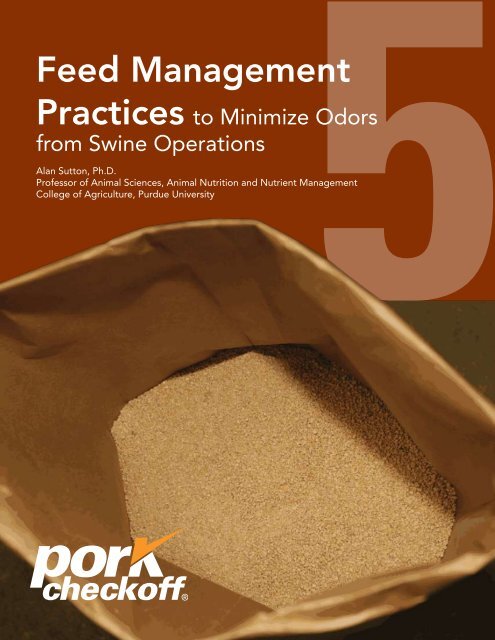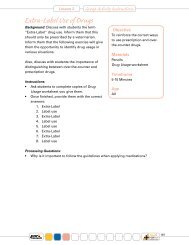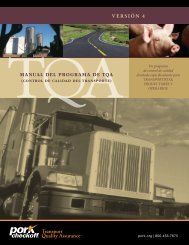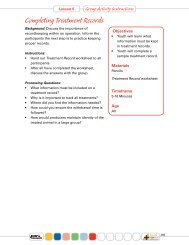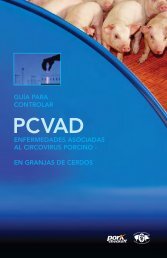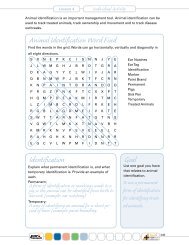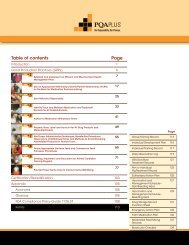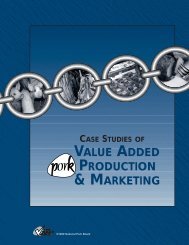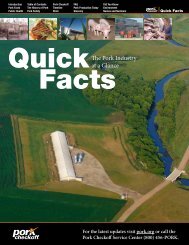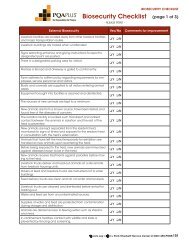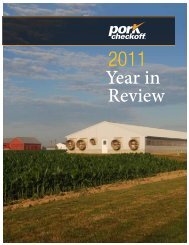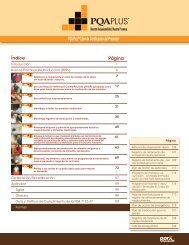Feed Management Practices to Minimize Odors from Swine ...
Feed Management Practices to Minimize Odors from Swine ...
Feed Management Practices to Minimize Odors from Swine ...
You also want an ePaper? Increase the reach of your titles
YUMPU automatically turns print PDFs into web optimized ePapers that Google loves.
5<br />
<strong>Feed</strong> <strong>Management</strong><br />
<strong>Practices</strong> <strong>to</strong> <strong>Minimize</strong> <strong>Odors</strong><br />
<strong>from</strong> <strong>Swine</strong> Operations<br />
Alan Sut<strong>to</strong>n, Ph.D.<br />
Professor of Animal Sciences, Animal Nutrition and Nutrient <strong>Management</strong><br />
College of Agriculture, Purdue University
Introduction<br />
Among the issues that can affect pork producers in<br />
the United States is concern about the potential for<br />
generation of odors <strong>from</strong> swine operations. <strong>Swine</strong><br />
farms have the potential <strong>to</strong> emit various gasses that<br />
can serve as a source of odors and that can affect the<br />
quality of the air surrounding the farm.<br />
<strong>Feed</strong> management<br />
techniques can have a<br />
significant impact on odor<br />
generation and control.<br />
Nutrients in the manure are one potential source of<br />
odor emissions. Since the pig is the source of manure<br />
nutrient excretions, feed management techniques<br />
can have a significant impact on odor generation and<br />
control. The forms, levels and source ingredients of<br />
pig diets and feed management practices used on the<br />
farm can influence the level of nutrients excreted in<br />
pig manure that can have a direct impact on gas and<br />
odor emissions. After excretion and during s<strong>to</strong>rage,<br />
anaerobic microbial degradation of organic matter in<br />
animal manure generates gasses and the potential for<br />
odors.<br />
Numerous compounds have been identified <strong>from</strong> the<br />
anaerobic degradation of animal manure. These have<br />
been generally grouped as volatile sulfur compounds,<br />
indoles and phenols, volatile fatty acids, ammonia<br />
and volatile amines. Many of these compounds<br />
(ammonia and volatile sulfur compounds) come <strong>from</strong><br />
the degradation of amino acids and proteins. Many of<br />
the volatile organic acids, phenols and methane come<br />
<strong>from</strong> degradation of specific amino acids and starch,<br />
and degradation of a multitude of organic compounds.<br />
<strong>Feed</strong> <strong>Management</strong><br />
Any diet formulation and management procedure<br />
that improves the overall efficiency of feed nutrient<br />
utilization by the pig should:<br />
• Reduce the <strong>to</strong>tal amount of manure produced,<br />
• Reduce levels of nutrients excreted in the manure,<br />
• Potentially decrease the precursors <strong>to</strong> volatile compounds,<br />
• Potentially decrease the emissions of gasses, and<br />
• Control the potential for generating offensive odors.<br />
Improving the feed efficiency by 0.1 points will<br />
generally result in a 3.3 percent reduction in nutrient<br />
excretion (assuming similar growth and nutrient<br />
retention in the animal).<br />
Other feed management practices that enhance feed<br />
efficiency and reduce nutrient excretion include:<br />
• <strong>Feed</strong> processing techniques such as fine grinding or<br />
pelleting,<br />
• Dividing the pig’s growth period in<strong>to</strong> phases and<br />
feeding different formulations <strong>to</strong> accommodate<br />
feed intake and nutrient requirements in each phase<br />
(phase feeding), and<br />
• Formulating diets <strong>to</strong> match nutrient requirements of<br />
the sex of the pig, or split-sex feeding.<br />
Reducing the particle size of feed through fine<br />
grinding will increase the surface area of the grain<br />
particles and allow greater interaction of digestive<br />
enzymes <strong>to</strong> free nutrients for use by the pig. When<br />
particle size is reduced <strong>from</strong> 1000 microns <strong>to</strong> 600<br />
microns, dry matter and nitrogen (N) digestibility is<br />
increased 5 <strong>to</strong> 12 percent and nitrogen excretion<br />
in manure is reduced by 20 <strong>to</strong> 24 percent. A target<br />
particle size is between 650 <strong>to</strong> 750 microns and any<br />
additional reduction in particle size will increase<br />
processing costs and may increase the incidence<br />
of s<strong>to</strong>mach ulcers in pigs causing significant loss in<br />
performance or even death.<br />
Providing feed in a pellet form reduces feed wastage<br />
and dust and can improve nutrient utilization in the<br />
diet if proper pelleting procedures are followed.<br />
Overheating pellets may reduce protein utilization in<br />
the feed and, consequently, pig performance.<br />
The requirement of growing pigs for most available<br />
amino acids and minerals, expressed as a percentage<br />
of the <strong>to</strong>tal diet decreases as the pigs grow heavier.<br />
Phase feeding and split-sex feeding allow the producer<br />
<strong>to</strong> formulate diets <strong>to</strong> more closely meet the animal’s<br />
protein and other nutrient requirements. These<br />
management practices may result in:<br />
• Less feed wastage,<br />
• Reduced feed costs, and<br />
• Reduced nutrients excreted in the manure.
For example, increasing the number of phases in<br />
grow-finish <strong>from</strong> one <strong>to</strong> three can reduce nitrogen<br />
excretion in manure by 15 percent and ammonia<br />
emissions by 17 percent. <strong>Feed</strong>ing three or four diets<br />
during the grow-finish period compared <strong>to</strong> feeding<br />
only two diets could reduce nitrogen excretion by<br />
5 <strong>to</strong> 8 percent. Additional reductions in ammonia<br />
emissions <strong>from</strong> three or more phases may be realized<br />
depending upon the initial protein levels in the diet<br />
of the pig. There have been increased reductions of<br />
ammonia emissions of 45 percent and odors of 55<br />
percent reported when more phases of feeds are fed<br />
throughout the life cycle of the pig.<br />
Similarly, split-sex feeding will result in a reduction in<br />
nutrient excretion, savings in diet costs and minimizing<br />
gas emissions.<br />
Proper feeder management is essential <strong>to</strong> reduce<br />
feed wastage and improve the efficiency of feed<br />
utilization in the swine operation. Studies have shown<br />
that feed waste can account for up <strong>to</strong> 3 <strong>to</strong> 8 percent<br />
of the feed offered. Spilled feed provides a readily<br />
available source of nutrients for bacterial activity in the<br />
manure system that can create additional gas emissions<br />
and odors. Routinely checking feeder adjustment can<br />
greatly reduce this problem and help save money. In<br />
addition, proper s<strong>to</strong>rage of feed is important. Spoiled<br />
feed causes odors and is costly <strong>to</strong> the operation.<br />
Therefore, using “good housekeeping” practices<br />
of routinely cleaning up spilled and spoiled feed is<br />
imperative.<br />
<strong>Feed</strong>s and the feed delivery system can generate<br />
considerable dust in swine buildings. Dust can cause<br />
the threat of respira<strong>to</strong>ry ailments <strong>to</strong> the pigs, in<br />
addition <strong>to</strong> carrying gases, odors and bacteria in<strong>to</strong> the<br />
atmosphere. Therefore, minimizing dust will improve<br />
the environmental conditions inside and outside of the<br />
building. A low-dust emission feed distribution system<br />
or adding fat <strong>to</strong> the diet (1 percent or more) will reduce<br />
dust formation in the building. Liquid feeding pigs<br />
(3:1 water <strong>to</strong> feed ratio) has been shown in European<br />
studies <strong>to</strong> reduce dust in the buildings and reduce<br />
odors by 23 <strong>to</strong> 31 percent.<br />
Diet Formulation<br />
There are numerous<br />
feed ingredients that can<br />
be formulated in<strong>to</strong> pig<br />
diets; however, availability<br />
and cost of ingredients<br />
generally dictate the<br />
selection of feeds used<br />
in the diet assuming that<br />
performance goals will be<br />
met.<br />
Producers often include additional nutrients <strong>to</strong> the<br />
diets as a “safety fac<strong>to</strong>r” <strong>to</strong> ensure that the potential<br />
for pig performance is reached. Excess nutrients in<br />
the resulting diet may result in substantial excretion of<br />
these nutrients in the manure increasing gas and odor<br />
emissions. Therefore, formulation of nutrients in the<br />
diet <strong>to</strong> closely meet the nutrient requirements of the<br />
animals must be followed. This can be met by following<br />
National Research Council (NRC) requirements or<br />
industry standards for specific genetic lines of pigs.<br />
Formulation of diets on an available or digestible<br />
nutrient basis will help meet animal requirements<br />
without excessive nutrients being placed in the diet and<br />
resultant excessive nutrient excretion. Routine analysis<br />
of feed ingredient sources and estimates of nutrient<br />
availability are needed <strong>to</strong> accomplish accurate feed<br />
formulation.<br />
Diets including byproducts such as dried distillers<br />
grains and solubles (DDGS) <strong>from</strong> ethanol production<br />
must be formulated carefully because of the<br />
ingredient’s nutrient variability. In some cases, these<br />
byproducts can increase the availability of nutrients,<br />
create an imbalance in some nutrients or provide excess<br />
levels of nutrients above the animal requirements.<br />
Balancing the diet <strong>to</strong> avoid excessive excretion<br />
of nitrogen, sulfur and carbohydrate compounds is<br />
optimal <strong>to</strong> mitigate gas emissions and odors.<br />
Liquid feeding pigs (3:1<br />
water <strong>to</strong> feed ratio) has<br />
been shown <strong>to</strong> reduce dust<br />
in the buildings and reduce<br />
odors by 23 <strong>to</strong> 31 percent.
Protein<br />
The level and source of protein in pig diets is<br />
important. The availability of amino acids and the<br />
relative ratio of certain amino acids <strong>to</strong> each other in<br />
a diet will dictate the amount of excess nitrogenous<br />
compounds such as ammonia that will be excreted.<br />
Soybean meal is the most commonly used protein<br />
source in pig diets in the United States. However,<br />
the amino acid ratios in a corn-soybean meal based<br />
diet are not ideal <strong>to</strong> meet the pig’s requirements.<br />
The introduction of the “ideal protein” concept<br />
implemented the use of synthetic amino acids in<br />
reduced crude protein (or reduced soybean meal) diets<br />
so that less excess amino acids would be present in the<br />
diet and less nitrogen would be excreted. Considerable<br />
research has shown that pigs fed reduced crude protein<br />
in diets supplemented with synthetic amino acids will<br />
perform similar <strong>to</strong>, or better than, pigs on corn-soybean<br />
meal diets with no synthetic amino acid additions.<br />
However, carcasses of pigs fed the low crude protein<br />
diets will generally have slightly higher backfat depths.<br />
The use of high quality protein sources that have a<br />
good balance of amino acids (a high biological value) or<br />
reducing the crude protein level in the diet and using<br />
synthetic amino acids will allow one <strong>to</strong> meet the dietary<br />
requirement of pigs and reduce nitrogen excretion and<br />
the potential for gas emissions.<br />
Research has shown that a 3.5 <strong>to</strong> 4.5 percent<br />
reduction in crude protein in a corn-soy diet with<br />
synthetic amino acids (lysine, methionine, tryp<strong>to</strong>phan<br />
and threonine) fed <strong>to</strong> grow-finish pigs when compared<br />
<strong>to</strong> a standard commercial diet:<br />
• Reduced pH (0.4 units),<br />
• Lowered <strong>to</strong>tal nitrogen excretion (30 – 40 percent),<br />
• Lowered ammonium nitrogen excretion (20 – 31<br />
percent),<br />
• Reduced aerial ammonia emission (40 – 60 percent),<br />
• Reduced hydrogen sulfide emission (30 – 40 percent)<br />
and<br />
• Reduced <strong>to</strong>tal odors (30 – 40 percent).<br />
Based on numerous studies, for every percent of<br />
reduction in dietary crude protein, nitrogen excretion<br />
and ammonia emissions are reduced by 8 <strong>to</strong> 10 percent.<br />
Modifying the mineral mix with lower levels of sulfatecontaining<br />
mineral sources in the pig’s diet will:<br />
Aid in reducing volatile sulfur compound emissions.<br />
However, the availability of the minerals for use by<br />
the pig in these alternate mineral sources and costs of<br />
these mineral sources must be considered. Similarly, the<br />
amount of synthetic amino acids that can be formulated<br />
in the diet will depend upon their cost versus natural<br />
protein sources (generally soybean meal).<br />
Based on numerous studies,<br />
for every percent of reduction in<br />
dietary crude protein, nitrogen<br />
excretion and ammonia<br />
emissions are reduced by<br />
eight <strong>to</strong> 10 percent.<br />
Table 1. Protein sources and their effect on odor<br />
DDGS Soy protein Blood meal Fish meal Feather meal Yeast<br />
• Phosphorous (P) availability increased<br />
• Potential increase in P excretion if high<br />
inclusion rate<br />
• Amino acid digestibility potentially reduced<br />
• Additional nitrogen (N) excretion may result<br />
when synthetic amino acids are included <strong>to</strong><br />
replace low digestibility amino acids <strong>from</strong><br />
DDGS<br />
At 5-10 percent inclusion<br />
• No difference in N and P manure content<br />
• <strong>Odors</strong> increase as inclusion rates increase<br />
At 10 percent inclusion<br />
• One study shows no difference in odor<br />
• Soy Concentrates<br />
reduce N excretion<br />
• Soy concentrates<br />
improve feed efficiency<br />
• Soy concentrates<br />
increase organic acids<br />
• Soy isolates increase<br />
alcohols in manure<br />
• May have an impact<br />
on odor<br />
At 1-3 percent<br />
• No impact<br />
on odors<br />
At 17<br />
percent<br />
• High<br />
odor<br />
scores<br />
At 12 percent<br />
• High odor<br />
scores<br />
• Added high<br />
level of sulfur<br />
<strong>to</strong> diet<br />
At 2-5 percent<br />
• Reduced<br />
odorous<br />
compounds –<br />
indole and<br />
ska<strong>to</strong>le – in<br />
manure<br />
• Did not<br />
affect human<br />
test panel<br />
measurements<br />
of odor
Energy (carbohydrate sources; fiber)<br />
The source of carbohydrates and fiber included in pig<br />
diets also can affect gas and odor emissions. In some<br />
cases, the amount of odors emitted may not change,<br />
however, the composition or character of the odors<br />
may change dramatically. Carbohydrates and nonstarch<br />
polysaccharides (carbohydrates that are highly<br />
fermentable in the gastrointestinal tract of the pig) are<br />
prime precursors for compounds such as the short chain<br />
volatile fatty acids, alcohols and other volatile organic<br />
acids.<br />
Cereal grains, such as corn, barley, wheat, sorghums<br />
and oats are common examples of carbohydrate<br />
sources with varying levels of starch and non-starch<br />
polysaccharides.<br />
Generally, corn is the more frequently used energy<br />
source in the pig’s diet. In some areas of the United<br />
States, barley and wheat are commonly used in pig<br />
diets. Often, when grains containing high fiber content<br />
are used <strong>to</strong> replace corn in the pig’s diet:<br />
• The amount of manure produced is higher,<br />
• Nutrient excretion can be higher, and<br />
• Odor generation is changed with less ammonia<br />
emissions but possibly greater volatile fatty acid<br />
emissions. This generally takes place when the fiber<br />
content increases in the diet or when specific fiber<br />
sources are added <strong>to</strong> the diet.<br />
Sources of fiber are often added <strong>to</strong> sow diets because<br />
of the laxative effect of fiber on lactating sows and<br />
the need <strong>to</strong> limit energy in gestating sows. However,<br />
because fiber is not effectively utilized by growing pigs,<br />
it is not added <strong>to</strong> nursery pig diets and generally not<br />
added <strong>to</strong> grow-finish pig diets.<br />
Depending on the level and source of fiber, potential<br />
negative impacts of fiber addition <strong>to</strong> a pig diet are:<br />
• Reduced digestibility of protein,<br />
• Reduced digestibility of fat,<br />
• Reduced digestibility of minerals, and<br />
• Reduced digestibility of energy.<br />
• Reduced pig performance (live weight gain and feed<br />
efficiency) as a result of lower digestibility of feed<br />
ingredients.<br />
Pigs may compensate for reduced available energy<br />
in the diet by consuming more feed, which also results<br />
in an increased production of manure. The reduction<br />
in dietary energy <strong>from</strong> the inclusion of fiber can be<br />
compensated for by adding more fat <strong>to</strong> the diet.<br />
The addition of fermentable carbohydrates <strong>to</strong> diets<br />
results in less nitrogen excretion in urine as urea, a<br />
shift <strong>to</strong> more nitrogen excretion in feces and a reduced<br />
pH of the manure. As a result, the nitrogen excreted<br />
is much more stable <strong>to</strong> degradation when manure<br />
is s<strong>to</strong>red and applied <strong>to</strong> cropland and there is less<br />
ammonia emission.<br />
Some examples of fermentable carbohydrates are<br />
soybean hulls, sugar beet pulp, wheat bran or midds<br />
and distillers grains. Other more unique carbohydrate<br />
sources are coconut meal, pota<strong>to</strong> starch, safflower meal<br />
and sunflower meal.<br />
Many sources of carbohydrates and fiber available<br />
<strong>to</strong> producers have yet <strong>to</strong> be tested on their impact on<br />
odor or gaseous emissions.<br />
Table 2. Fermentable carbohydrates and their effect on odor<br />
Soybean hulls Wheat bran, wheat midds Sugar beet pulp<br />
• A 17 <strong>to</strong> 36 percent reduction in ammonia<br />
(NH 3<br />
) emissions<br />
• May increase short chain volatile fatty<br />
acids (VFA) in feces<br />
Inclusion of 10 percent with 3.4 percent fat<br />
<strong>to</strong> a standard commercial diet<br />
• Reduced aerial NH by 20 percent<br />
3<br />
• Reduced hydrogen sulfide (H S) by<br />
2<br />
32 percent<br />
• Reduced odor threshold by 11 percent<br />
• Nitrogen (N) in manure increased<br />
21 percent<br />
• pH of manure decreased<br />
• VFA increased 32 percent in manure<br />
Five percent inclusion with reduced crude<br />
protein and supplemental amino acids in<br />
corn-soy diets<br />
Reduced aerial NH by 50 percent<br />
•<br />
3<br />
• Reduced aerial H2 S by 48 percent<br />
• Reduced odor detection threshold by<br />
37 percent<br />
Ten percent inclusion with reduced crude<br />
protein and supplemental amino acids in<br />
corn-soy diets<br />
• Reduced ammonia N by 22 percent<br />
• Little effect on VFA emissions<br />
• Additional research is needed <strong>to</strong><br />
determine effect on odor and gas<br />
emissions<br />
• Odorous compound emissions have<br />
been variable<br />
• Additional research is needed <strong>to</strong><br />
determine effect on odor
Other <strong>Feed</strong> Ingredients<br />
Inorganic forms of minerals are commonly added <strong>to</strong><br />
diets <strong>to</strong> meet specific mineral nutrient requirements of<br />
the pig. Depending upon costs and availability, some<br />
mineral sulfates are used, which may be a source of<br />
sulfur odor compounds. Even though sulfur amino acids<br />
are the primary source of volatile sulfur compound<br />
generation, mineral sources can also contribute.<br />
Organic forms of minerals are more biologically<br />
available and smaller amounts are required in the diet<br />
<strong>to</strong> meet the pig’s needs. This results in less excretion of<br />
minerals and potentially less volatile sulfur compound<br />
emissions. However, the effect of organic mineral<br />
sources on odors and volatile sulfur gas emissions has<br />
not been determined.<br />
Organic forms of minerals are<br />
more biologically available<br />
and smaller amounts are<br />
required in the diet <strong>to</strong> meet<br />
the pig’s needs. This results in<br />
less excretion of minerals and<br />
potentially less volatile sulfur<br />
compound emissions.<br />
Attempts have been made <strong>to</strong> isolate and identify<br />
the microbial populations in the digestive systems<br />
of pigs that control or are involved in the creation of<br />
odors. Compounds such as dairy byproducts (lactulose,<br />
lacti<strong>to</strong>l, lac<strong>to</strong>se and whey), and organic acids (propionic,<br />
fumaric and citric) have been added <strong>to</strong> manipulate the<br />
microflora populations in pig digestive systems.
Table 3. Other feed ingredients and their effect on odor*<br />
Growth<br />
promoters<br />
Dietary calcium salts<br />
(sulfate, chloride<br />
and benzoate)<br />
Ben<strong>to</strong>nite<br />
and zeolite<br />
Organic<br />
acids<br />
Enzymes<br />
(protease, amylase,<br />
and carbohydrase)<br />
• Improve feed<br />
efficiency 5 <strong>to</strong> 10<br />
percent<br />
• Potentially reduces<br />
odors<br />
Beta-agonist<br />
• Reduce N excretion<br />
• Reduce NH in slurry<br />
3<br />
• Reduce NH emissions<br />
3<br />
• Reduce volatile fatty<br />
acids<br />
Calcium benzoate at<br />
increasing levels (2,4 and<br />
8g /kg of feed) in sows<br />
• Reduced pH of urine<br />
<strong>from</strong> 7.7 <strong>to</strong> 5.5<br />
• Reduced ammonia<br />
(NH 3<br />
) emissions up <strong>to</strong><br />
53 percent<br />
Calcium benzoate is<br />
currently not approved for<br />
animal feeds.<br />
Calcium chloride at 1.96<br />
percent in nursery diets<br />
• Reduced NH3<br />
emissions <strong>from</strong><br />
nursery rooms<br />
• Reduced feed intake<br />
• Depressed<br />
performance<br />
• Effect on NH3<br />
emissions is<br />
inconclusive<br />
• Minimal effect<br />
on odor<br />
• Citric, hydrochloric,<br />
propionic, fumaric and<br />
sulfuric acid at dietary<br />
levels of 1 <strong>to</strong> 4 percent<br />
• Variable results on the<br />
pH of the digestive<br />
contents and pig<br />
growth.<br />
Fumaric or citric acid<br />
addition at 1.5 percent<br />
• Very little effect on pH<br />
• Very little effect on<br />
volatile fatty acid<br />
concentrations of<br />
intestinal contents of<br />
pigs.<br />
Adipic acid inclusion<br />
• Reduces pH<br />
• Reduces NH emissions<br />
3<br />
• Does not improve lysine<br />
utilization<br />
• Improve the<br />
digestibility of<br />
specific nutrients<br />
• Can reduce manure<br />
generation<br />
• May reduce<br />
potential odor<br />
generation.<br />
There has been little<br />
research on the effects of<br />
organic and inorganic acids<br />
on gas and odor emissions.<br />
*Individual operations need <strong>to</strong> evaluate the use of these ingredients as cost and availability will vary.
Summary<br />
Techniques <strong>to</strong> increase the availability and retention<br />
of nutrients can reduce excretion of compounds in<br />
manure that commonly cause odors. <strong>Feed</strong> management<br />
practices such as formulating diets <strong>to</strong> meet the<br />
requirements of specific genetic lines, phase feeding,<br />
split-sex feeding, minimizing feed wastage and<br />
feed processing technologies will assist in reducing<br />
nutrient excretions. Implementation of several of these<br />
technologies and practices, often in combination,<br />
has the potential of reducing ammonia and hydrogen<br />
sulfide emissions by 30 <strong>to</strong> 50 percent and reducing<br />
odors by 30 percent at very little additional cost <strong>to</strong> the<br />
producer.<br />
Implementation of several<br />
of these technologies<br />
and practices, often in<br />
combination, has the<br />
potential of reducing<br />
ammonia and hydrogen<br />
sulfide emissions by 30 <strong>to</strong><br />
50 percent and reducing<br />
odors by 30 percent at<br />
very little additional cost<br />
<strong>to</strong> the producer.<br />
Additional Resource Information:<br />
Baidoo. 2007. <strong>Feed</strong>ing strategies for manipulating<br />
manure content. Mani<strong>to</strong>ba Agriculture, Food and Rural<br />
Initiatives. University of Mani<strong>to</strong>ba, Winnipeg, Mani<strong>to</strong>ba.<br />
van Kempen and van Heugten. 2003. Impact of diet<br />
on odor. NCSU <strong>Swine</strong> Report. North Carolina State<br />
University. Raleigh, N.C.<br />
van Heugten and van Kempen. 2000. Understanding<br />
and applying nutrition concepts <strong>to</strong> reduce nutrient<br />
excretion in swine. North Carolina State University<br />
Bulletin No. AG-608. North Carolina State University.<br />
Raleigh, N.C.<br />
Kornegay and Harper. 1997. Environmental nutrition:<br />
Nutrient management strategies <strong>to</strong> reduce nutrient<br />
excretion in swine. The Professional Animal Scientist<br />
13:99-111.<br />
Richert and Sut<strong>to</strong>n. 2006. Nutrition, nutrient excretion<br />
and odor: Current and future opportunities. Proc. 37th<br />
Annual Meeting of the American Association of <strong>Swine</strong><br />
Veterinarians. Kansas City, Mo<br />
Prince, Sut<strong>to</strong>n, von Bernuth and Verstegen. 2000.<br />
Application of nutritional knowledge for developing<br />
econutrition feeding programs on commercial swine<br />
farms. Proc. American Society of Animal Science.<br />
1999. Online. http://www.asas.org/jas/symposia/<br />
proceedings/0931.pdf<br />
Sut<strong>to</strong>n, Kephart, Verstegen, Canh and Hobbs. 1999.<br />
Potential for reduction of odorous compounds in<br />
swine manure through diet modification. J. Anim. Sci.<br />
77:430-439.<br />
Le, Aarnink, Ogink, Becker and Verstegen. 2005. Odour<br />
<strong>from</strong> animal production facilities: its relationship <strong>to</strong> diet.<br />
Nutr. Res. Rev. 18:3-30.<br />
<strong>Feed</strong> management practices along with feed<br />
formulation can affect nutrient excretions and ultimately<br />
gaseous and odor emissions <strong>from</strong> manure. Inclusion of<br />
enzymes <strong>to</strong> enhance feed utilization can reduce nutrient<br />
excretions and reduce potential gaseous emissions<br />
and the potential for odor generation on swine farms.<br />
Amino acid balanced (correct ratios and concentrations)<br />
diets with lower crude protein levels and addition of<br />
small amounts of fiber (less than10 percent) can be<br />
effective in reducing aerial ammonia, hydrogen sulfide,<br />
manure nitrogen, pH and odors. The relative costs of<br />
these practices must be considered when implementing<br />
them.<br />
To learn more about odor<br />
mitigation practices, visit<br />
the Checkoff-funded Air<br />
<strong>Management</strong> <strong>Practices</strong><br />
Assessment Tool at http://<br />
www.extension.iastate.<br />
edu/airquality/practices/<br />
homepage.html.<br />
©2008 National Pork Board, Des Moines, IA USA This message funded by America’s Pork Checkoff program. #04823-07/08


